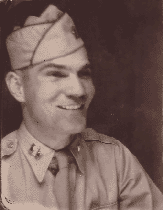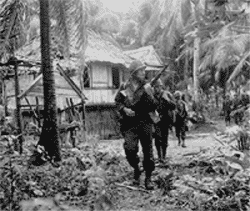6th Battalion
 Active from 26 September, 1944 to 30 December, 1945
Active from 26 September, 1944 to 30 December, 1945
(per Ranger Memorial Fort Benning, GA)
Strausbaugh Remembers
The 98th Field Artillery Battalion was a regular army mule pack artillery unit stationed in Camp Carson, Colorado in 1942. The unit consisted of three firing batteries plus headquarters and service battery. The unit had the 75 millimeter howitzer for fire power and nearly 1000 men and 800 mules. On 13 December, 1942 the unit was sent to Camp Patrick Henry, Virginia via rail to a staging area for overseas debarkation. Soon thereafter, the mules were sent to a port in San Francisco to be loaded on an animal ship for overseas destination. The 98th arrived at Camp Patrick Henry on 31 Jan 1943 after a two day stop going through the Panama Canal. A tent camp was set up at the edge of Brisbane awaiting the arrival of the mules. However, the Australian government refused to allow the mules to enter the country due to a law forbidding the importation of foreign animals. So, on the 9 February 1943, the unit was sent to New Guinea via Liberty ship. They arrived on the 17th of February and set up a tent camp about 20 miles from Port Moresby. The mules arrived a few days later. For the next year it was training, but no action and 6th Army decided the unit was obsolete and sent the mules to the CBI theater. The battalion commander LTC Callicut was transferred to the 1st Cavalry. A new battalion commander arrived by the name of LTC Henry "Hank" Mucci. Mucci was a short but well built 33 year old West Point graduate who had come from Hawaii where he operated a Ranger type training camp.
Army Rangers
Mucci informed the battalion that it was being converted to Rangers and a large turn over of personnel began. He was brilliant as a leader, but demanded the best from all his men "or out you went". The Rangers only needed 500 men, so half were sent out very soon after training began. The new officers arriving were primarily infantry and two were engineers.
Finchhaven, New Guinea
By 1 July 1944, the battalion had pretty well completed the necessary training, so they were sent to Finchhaven where the unit was reorganized into the T O and E of a Ranger Battalion which consisted of six rifle companies, headquarters and service company combined.

(Photo courtesy of Ranger Strausbaugh, author of the 6th Battalion summary)
Off to the Philippines
D-day invasion of the Philippines was designated as 20 October 1944 with a large invasion on the beaches of Leyte Gulf. However, the Rangers were given an assignment to land on D minus three to take control of three islands at the entrance of Leyte Gulf, so as to eliminate any interference with the main invasion. The companies of A, C, E, F, and HQ personnel to land on Dinagat, B company along with reinforcements from some HQ personnel to land on Homonhon and D company to land on Suluan and destroy a light house the Japanese were using for communications for ships and aircraft. The battalion left Finchhaven on 10 October 1944 on three APD's for a seven day trip. Four days out a large typhoon hit the convoy. It was so bad that the navy felt the ships would not survive so they held back two of the three APD's, but company D attempted to land on Suluan. It did not work out and they were forced to withdraw. PFC Zufall was killed by the Japanese and became the first 6th Battalion Ranger KIA. The next day, the 18th, the weather was great and the units landed and accomplished their mission. The Rangers on Dinagat erected the first American Flag in the return to the Philippines. B company met no resistance on Homohon so they were ordered to go to this small island of Suluan and destroy the lighthouse. Navy transportation was not available, so they had the Filipinos take them across the water some four miles in sail boats. The Rangers were able to destroy the lighthouse and many of the Japanese troops in what turned out to be a twelve-hour mission. It nearly became a disaster when Cpt Bull Simons and DR Jim Fisher and several other Rangers had to be rescued by Lt Leo Strausbaugh's platoon. Soon, all the Ranger companies joined together near Tacloban on the island of Leyte. They did primarily patrolling until the order came through for their participation of the Lingayen Gulf invasion of Luzon.
Luzon
On New Years Day, 1 January 1945, the 6th Rangers loaded on a ship in the harbor of Tacloban and joined a convoy heading north. The Rangers landed on Lingayen Gulf beach on 10 January 1945. B company was soon sent to Santiago Island to defend the entrance to the Gulf and deny the enemy any foothold behind the American forces.
Cabanatuan Raid
Army Intelligence had now determined that the Japanese were holding a large number of POW's in a prison camp 30 miles northeast of Manila in Cabanatuan near Cariboua, Neuva Ecija, Province. Most of the prisoners had survived the Bataan Death March. The 6th Rangers were given the assignment to "bring the prisoners out alive." LTC Mucci selected Captain Robert Prince who commanded C company as assault commander and also a platoon of F company commanded by Lt. Murphy. Alamo Scouts were assigned the mission of forward scouting and Filipino guerillas for flank protection. The rescuers departed on their mission at dusk to walk 30 miles to the prison camp, crawling the last mile on their stomachs. They arrived at the camp about daylight 30 January. They hit the camp and brought out 512 prisoners of war, killed about 200 enemy troops, but lost only two Rangers, one being the Fisher, Battalion surgeon, who was killed by a mortar shell. He is the same Fisher who was rescued on Suluan. Some prisoners were able to walk, others rode carabao carts provided by Filipinos, while Rangers carried some like babies who were too emaciated to walk or ride. They were eventually picked up by ambulances and taken to 92nd Evacuation Hospital in Guimba. Much credit goes to the P-61 Black Widow pilots who flew over the camp and created a threat to the guards so they failed to spot the approaching Rangers. General MacArthur said after the raid, "No incident in this war has given me greater pleasure". Sixth Army commander General Walter Krueger later decorated all the Rangers with LTC Mucci and Captain Prince receiving the DSC, the other officers were awarded the Silver Star and the enlisted men the Bronze Star. A few of the Rangers and scouts were sent back to the US to meet President Roosevelt, Chief of Staff Gen George Marshall, and made numerous speeches throughout the United States.
After the Raid
The battalion moved to the town of San Fernando, 40 miles north of Manila, and occupied seven houses, as their base of operation. Soon after the raid, LTC Mucci was transferred to the Sixth Division and became a Regimental Commander and was promoted to Colonel. Major Robert "Woody" Garrett became the new battalion commander and promoted to Lt. Colonel, Captain Bill Simons then became battalion exec and made Major and Lt. Leo Strausbaugh replaced him as B Company commander and promoted to Captain. The battalion did not operate as a unit, but as individual companies. Missions included Ipo Dam, Cararuan Hills, Dingalen Bay, running patrols for the 6th Division, destroying a pillbox west of San Fernando, Baugio area, and so many more.....
Aparri Operation
In late May 1945, Sixth Army formed a task force that would join together on the northern tip of Luzon which would have a mission of taking the town of Aparri which was on the east side of the Cagayan River, then control the airfield to the south of Aparri and continue south to meet up with the 37th Division which was moving north up the valley. This would result in dividing the Japanese forces, if the Americans controlled the road running north and south. The Army requested a company of Rangers to join the task force and spearhead the assault on Aparri. LTC Garrett selected Captain Strausbaugh's B company for the mission. On 1 June, B company dug in on the west side of the river waiting to attack after the artillery and PT boats blasted the town of Aparri. They crossed the river on 21 June 1945, secured the town of Aparri, moved south, and took the airfield just prior to a paratroops jump by a battalion from the 11th Airborne Division. The Rangers then drove south till they made contact with elements of the 37th Division. B company was then relieved and flew back to San Fernando. The mission lasted 30 days.
Atomic Bomb
The Aparri operation ended the combat days in the Philippines for the 6th Rangers and they began to prepare for the invasion of Japan. When the Atom bomb was dropped on Japan on 6 August 1945, which led to the surrender, the Rangers were sent to Japan as occupation forces. On 30 December 1945, the unit was deactivated in Japan. The Rangers were either sent home or assigned to other units.
- Contributed by Leo V. Strausbaugh
Col AUS Retired

(US Army Photo Public Domain)
"In a nation at war, teamwork by the whole people is necessary for victory. But the issue is decided on the battlefield, toward which all national effort leads. The country's fate lies in the hands of its soldier citizens; in the clash of battle is found the final test of plans, training, equipment, and-above all-the fighting spirit of units and individuals."
- Dwight D. Eisenhower
Recommended Ranger Links
- Research Reading List
- Rangers in World War II (An excellent comprehensive account of all six Battalions by Ranger Robert W. Black)
- Ghost Soldiers (More on the 6th Battalion Ghost Soldiers by Hampton Sides)
- Bataan Death Memorial Photos (from Limbourg Philippe)
 DESCENDANTS OF WWII RANGERS, INC
DESCENDANTS OF WWII RANGERS, INC 